Battles of the Somme 1916
Preparations for the Offensive
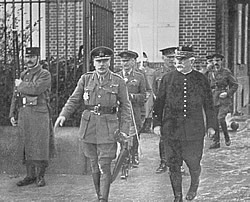
|
An offensive on the Somme battlefront was proposed by the Commander-in-Chief of the French Armies, General Joseph Joffre, as the year of 1915 turned into 1916. Originally intended as a combined Franco-British operation on both sides of the Somme river, the French reduced their participation to a supporting role in the operation as a result of the large-scale German attack on the Verdun front from February 1916.
The British Fourth Army was formed in March 1916 and it took over the Somme battlefront from the British Third Army between Fonquevillers and Maricourt on the Somme river. The British operational plan for an offensive between Serre on the left wing and Maricourt on the right wing developed during April, May and June 1916. It was approved that the Third Army would commit two infantry divisions for a subsidiary attack at the same time as the main offensive against the heavily fortified German front at Gommecourt on the Fourth Army's northern left flank. On the other side of the wire opposite the British line north of the Somme river five German frontline divisions were in position to defend their Front Line, with four in reserve and/or at rest.
Preparations
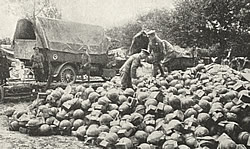
|
From the early spring of 1916 into June the Somme battlefield sector behind the British and French lines was the scene of a huge build-up of troops, artillery and equipment in preparation for the large-scale offensive against the German defensive line.
Preparatory Bombardment
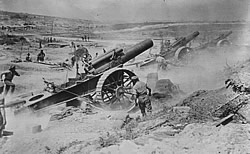
|
The artillery programme was for a bombardment, the intensity of which had not been witnessed before on this battlefront. The bombardment was to wear down the morale and nerves of the German defenders, cut through the German barbed wire defences and smash their Front Line trenches and rear supply routes. As a result of the postponement of the infantry attack to 1 July, there were two additional days of preparatory artillery bombardment, making it seven days in total.
The Troops Prepare for the Battle
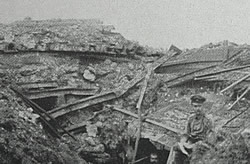
|
Final preparations of training and planning were made by the British infantry during the days of the preparatory bombardment. Raids and patrols were carried out. Reports about the wire were varied and at times conflicting. Generally it appeared from these reports that the wire had been better cut on the right of the Fourth Army front, south of the Albert-Bapaume road, than on the left front. During the night of 30 June into the early hours of 1 July thousands of British troops made their way on a moonless, but clear night along pre-prepared routes into their assembly positions in the forward lines, to get into position ready for Zero Hour at 07.30 on 1 July.
Battles of the Somme
- Battle of Albert
01-Jul-1916—
13-Jul-1916
- Subsidiary Attack: Gommecourt Salient
01-Jul-1916
- Battle of Albert (continued)
02-Jul-1916—
13-Jul-1916
Tactical Incidents in the Battle of Albert
In the days from 1 July until 13 July the following ground was captured by British forces:
- Capture of Montauban on 1 July by 30th Division
- Capture of Mametz by 7th Division
- Capture of Fricourt by 17th Division
- Capture of Contalmaison by 23rd Division
- Capture of La Boisselle by 19th Division
Battles continued in this sector into the following weeks as the British tried to break the German defence. The names of villages and woods on the Somme battlefields have become synonymous with the desperate fighting and tragic loss of both the British and German Armies during the four and a half months of these battles: Gommecourt, Serre, Beaumont Hamel, Thiepval, Ovillers, La Boisselle, Courcelette, Fricourt, Contalmaison, Mametz, Montauban, Bazentin, Longueval, Delville Wood, Martinpuich, High Wood, Flers.
Mines Exploded under German Positions
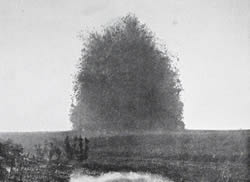
|
In order to knock out a number of key defensive positions in the German Front Line the British exploded eight large mines just before Zero Hour of 07.30 hours.
Lochnagar Mine Crater Memorial, La Boisselle
British Infantry Advance
In some parts of the British line troops had crawled out in front of the Front Line trench before Zero Hour. At Zero Hour 07.30 whistles blew all along the British Front Line north of the Somme river. Thousands of British troops clambered over the trench parapet into No Man's Land, making for the German Front Line.
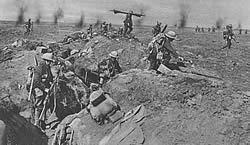
|
The British Official History records the moment:
“Under a cloudless blue sky which gave full promise of the hot mid-summer day which was ahead, wave after wave of British infantry rose and, with bayontets glistening, moved forward into a blanket of smoke and mist as the barrage lifted from the enemy's front trench. Almost simultaneously the German gunners ceased their counter-battery work and concentrated their fire upon the assault.” (7)
The tragedy of the day unfolded as thousands of British troops were cut down and wounded or killed by German machine gun and rifle fire. Many never even reached the German wire on the other side of No Man's Land.
At the end of the first day of the battle the Germans had successfully defended their positions more or less in tact north and south of the Albert—Bapaume road from between the villages of Gommecourt and Fricourt. However, to the east of Mametz village the British 18th and 30th Divisions of XIII Corps did make a successful breakthrough beyond the German Front Line, reaching their objective by the end of the day.
Heavy British Casualties
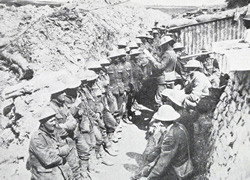
|
1 July was a tragic day for the British Army. There were some 60,000 casualties by the end of that day, 20,000 of whom were fatalities. Although the German regiments record relatively few casualties defending their line in the northern part of the battlefield two of their regiments in the south sector, where the British had successfully made a breakthrough, were decimated, each of them losing several hundred men as wounded, killed and taken prisoner.
- Battle of Bazentin
14-Jul-1916 —
17-Jul-1916
-
- Subsidiary action: Attack at Fromelles (on Aubers Ridge, Artois)
19-Jul-1916
- Subsequent action:
Attacks at High Wood
20-Jul-1916 —
25-Jul-1916
- Subsidiary action: Attack at Fromelles (on Aubers Ridge, Artois)
- Battle of Delville Wood
15-Jul-1916 —
03-Sep-1916
- Battle of Pozières
23-Jul-1916 —
03-Sep-1916
- Battle of Guillemont
03-Sep-1916—
06-Sep-1916
- Battle of Ginchy
09-Sep-1916
- Battle of Flers-Courcelette
15-Sep-1916—
22-Sep-1916
- Battle of Morval
25-Sep-1916—
28-Sep-1916
- Battle of Thiepval
26-Sep-1916—
28-Sep-1916
- Battle of Le Transloy
01-Oct-1916 —
18-Oct-1916
- Battle of the Ancre Heights
01-Oct-1916—
11-Nov-1916
- Battle of the Ancre, 1916
13-Nov-1916—
18-Nov-1916
The Battle of the Somme finally drew to a close as the winter weather worsened. It officially ended on 18 November 1916.